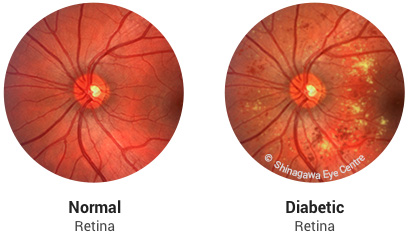Diabetic Eye Types

Diabetics are at a higher risk of developing eye complications, including retinal detachment and glaucoma. Although most people with diabetes have minor eye problems, some can develop serious issues that can lead to blindness. However, while many diabetics develop minor eye disorders, those that do require medical attention often begin at a young age. These treatments should be started early to minimize the risks and improve quality of life for people with diabetes.
Diabetic retinopathy is an advanced type of the disease in which blood vessels in the retina disappear and are replaced by more fragile blood vessels. This can lead to sudden vision loss. The risk of developing this condition is high for people with diabetes, as people with the condition have a 25-fold increased risk of developing it. While only half of people with diabetes have regular eye exams, a third of those who have diabetes never get them.
There are many treatments for diabetic retinopathy, ranging from medication to surgery. While most treatments are available over the counter, some people may need surgical procedures to treat their condition. These procedures involve removing a jelly-like substance called the vitreous and replacing it with a balanced saline solution. If this does not resolve the problem, doctors may opt for a surgical procedure called a vitrectomy.
Diabetic retinopathy, also known as retinopathy, affects the blood vessels in the retina, the light-sensitive layer of tissue at the back of the eye. Symptoms of retinopathy may include vision loss and even retinal detachment. The condition can lead to other complications, such as cataracts and open-angle glaucoma. It is important to seek proper medical care for diabetes to prevent further complications.
Diabetic retinopathy has different types. In the early stages, the disease is caused by a buildup of fluid within the eye, which leads to changes in vision. The advanced stage of the condition is known as proliferative retinopathy. The symptoms of diabetic retinopathy include changes in vision and blurred vision. Luckily, it can improve with proper diabetes management. But diabetes can also lead to other complications, such as cataracts.
The earliest symptoms of diabetes include blurred vision and decreased central vision. If the disease is detected at an early stage, patients with diabetes should seek help to treat the disease. It is important to avoid excessive sun exposure as this can lead to glaucoma, which causes blindness. Once the damage is done, it will eventually affect peripheral and central vision. To avoid these conditions, it is important to take proper preventive measures. The sooner you solve these problems, the better your vision will be.
Among the most common forms of diabetic eye disease is a condition called retinopathy. This disease causes blood vessels to build up in the retina and can lead to vision loss. This condition can also lead to complications such as glaucoma, cataracts and retinal amputation. It is extremely important to have an annual eye exam to avoid any complications. If you are diagnosed with diabetes, your doctor will examine your eyes to make sure the diagnosis is correct.
PDR is the most common form of diabetic eye disease. In this case, new blood vessels begin to grow in the retina. These blood vessels are fragile and can bleed into the vitreous, causing blurred vision. New blood vessels can also form scar tissue, which blocks vision and leads to other problems. This condition can eventually lead to blindness or vision loss. But there are many ways to treat diabetic eye diseases.
Various types of diabetic eye diseases can lead to vision loss. In addition to damaging the retina, this disease can lead to the formation of scar tissue. It is important to see a doctor to make sure the disease is not causing vision loss. If you have already been diagnosed with diabetes, your doctor can tell you if you have any of these eye conditions. You should also consult the website english.org.mx
and your doctor for testing if you suspect you have any of these.
If you have diabetes, you should see your doctor regularly for eye exams. Extensive examination allows early diagnosis of diabetic eye disease and prevents blindness. Your ophthalmologist will also give you tips on how to preserve your vision. The sooner you see an ophthalmologist, the higher your chances of maintaining your vision. It is also important to have regular checkups. It is very important to undergo extensive examination to ensure that the retina remains intact.